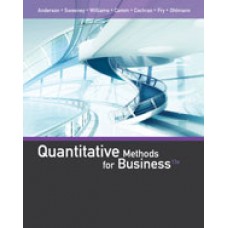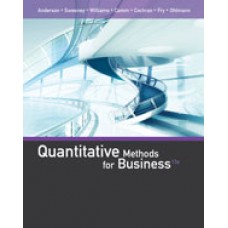Test Bank for Quantitative Methods for Business, 13th Edition Anderson
$55.00 Original price was: $55.00.$29.99Current price is: $29.99.
Test Bank for Quantitative Methods for Business, 13th Edition, Anderson,
Instant download Test Bank for Quantitative Methods for Business, 13th Edition, Anderson pdf docx epub after payment.

Product details:
- ISBN-10 : 1285866312
- ISBN-13 : 978-1285866314
- Author: James J. Cochran; David R. Anderson; Dennis J. Sweeney
You don’t have to be a mathematician to maximize the power of quantitative methods. Written for the current?or future?business professional, QUANTITATIVE METHODS FOR BUSINESS, 13E makes it easy for you to understand how you can most effectively use quantitative methods to make smart, successful decisions. The book’s hallmark problem-scenario approach guides you step by step through the application of mathematical concepts and techniques. Memorable real-life examples demonstrate how and when to use the methods found in the book, while instant online access provides you with Excel worksheets, LINGO, and the Excel add-in Analytic Solver Platform. The chapter on simulation includes a more elaborate treatment of uncertainty by using Microsoft Excel to develop spreadsheet simulation models. The new edition also includes a more holistic approach to variability in project management. Completely up to date, QUANTITATIVE METHODS FOR BUSINESS, 13E reflects the latest trends, issues, and practices from the field.
Table of contents:
- Chapter 1: Introduction
- 1.1: Problem Solving and Decision Making
- 1.2: Quantitative Analysis and Decision Making
- 1.3: Quantitative Analysis
- 1.4: Models of Cost, Revenue, and Profit
- 1.5: Quantitative Methods in Practice
- 1: Exercises (12)
- 1: Case Problems
- 1: Test Bank
- Chapter 2: Introduction to Probability
- 2.1: Experiments and the Sample Space
- 2.2: Assigning Probabilities to Experimental Outcomes
- 2.3: Events and Their Probabilities
- 2.4: Some Basic Relationships of Probability
- 2.5: Bayes’ Theorem
- 2.6: Simpson’s Paradox
- 2: Exercises (17)
- 2: Case Problems (1)
- 2: Exploring Analytics Applet Exercises (2)
- 2: Test Bank
- Chapter 3: Probability Distributions
- 3.1: Random Variables
- 3.2: Discrete Random Variables
- 3.3: Binomial Probability Distribution
- 3.4: Poisson Probability Distribution
- 3.5: Continuous Random Variables
- 3.6: Normal Probability Distribution
- 3.7: Exponential Probability Distribution
- 3: Exercises (27)
- 3: Case Problems (1)
- 3: Exploring Analytics Applet Exercises (5)
- 3: Test Bank
- Chapter 4: Decision Analysis
- 4.1: Problem Formulation
- 4.2: Decision Making Without Probabilities
- 4.3: Decision Making with Probabilities
- 4.4: Risk Analysis and Sensitivity Analysis
- 4.5: Decision Analysis with Sample Information
- 4.6: Computing Branch Probabilities with Bayes’ Theorem
- 4: Exercises (23)
- 4: Case Problems (1)
- 4: Test Bank
- Chapter 5: Utility and Game Theory
- 5.1: The Meaning of Utility
- 5.2: Utility and Decision Making
- 5.3: Utility: Other Considerations
- 5.4: Introduction to Game Theory
- 5.5: Mixed Strategy Games
- 5: Exercises (9)
- 5: Case Problems
- 5: Test Bank
- Chapter 6: Time Series Analysis and Forecasting
- 6.1: Time Series Patterns
- 6.2: Forecast Accuracy
- 6.3: Moving Averages and Exponential Smoothing
- 6.4: Linear Trend Projection
- 6.5: Seasonality
- 6: Exercises (36)
- 6: Case Problems (4)
- 6: Exploring Analytics Applet Exercises (3)
- 6: Test Bank
- Chapter 7: Introduction to Linear Programming
- 7.1: A Simple Maximization Problem
- 7.2: Graphical Solution Procedure
- 7.3: Extreme Points and the Optimal Solution
- 7.4: Computer Solution of the RMC Problem
- 7.5: A Simple Minimization Problem
- 7.6: Special Cases
- 7.7: General Linear Programming Notation
- 7: Exercises (33)
- 7: Case Problems
- 7: Exploring Analytics Applet Exercises (2)
- 7: Test Bank
- Chapter 8: Linear Programming: Sensitivity Analysis and Interpretation of Solution
- 8.1: Introduction to Sensitivity Analysis
- 8.2: Objective Function Coefficients
- 8.3: Right-Hand Sides
- 8.4: Limitations of Classical Sensitivity Analysis
- 8.5: More Than Two Decision Variables
- 8.6: Electronic Communications Problem
- 8: Exercises (19)
- 8: Case Problems
- 8: Test Bank
- Chapter 9: Linear Programming Applications in Marketing, Finance, and Operations Management
- 9.1: Marketing Applications
- 9.2: Financial Applications
- 9.3: Operations Management Applications
- 9: Exercises (12)
- 9: Case Problems
- 9: Test Bank
- 9: Test Bank
- Chapter 10: Distribution and Network Models
- 10.1: Supply Chain Models
- 10.2: Assignment Problem
- 10.3: Shortest-Route Problem
- 10.4: Maximal Flow Problem
- 10.5: A Production and Inventory Application
- 10: Exercises (20)
- 10: Case Problems
- 10: Test Bank
- Chapter 11: Integer Linear Programming
- 11.1: Types of Integer Linear Programming Models
- 11.2: Graphical and Computer Solutions for an All-Integer Linear Program
- 11.3: Applications Involving 0–1 Variables
- 11.4: Modeling Flexibility Provided by 0–1 Integer Variables
- 11: Exercises (14)
- 11: Case Problems
- 11: Exploring Analytics Applet Exercises (2)
- 11: Test Bank
- Chapter 12: Advanced Optimization Applications
- 12.1: Data Envelopment Analysis
- 12.2: Revenue Management
- 12.3: Portfolio Models and Asset Allocation
- 12.4: Nonlinear Optimization—The RMC Problem Revisited
- 12.5: Constructing an Index Fund
- 12: Exercises (15)
- 12: Case Problems
- 12: Exploring Analytics Applet Exercises (1)
- 12: Test Bank
- Chapter 13: Project Scheduling: PERT/CPM
- 13.1: Project Scheduling Based on Expected Activity Times
- 13.2: Project Scheduling Considering Uncertain Activity Times
- 13.3: Considering Time–Cost Trade-Offs
- 13: Exercises (16)
- 13: Case Problems
- 13: Test Bank
- Chapter 14: Inventory Models
- 14.1: Economic Order Quantity (EOQ) Model
- 14.2: Economic Production Lot Size Model
- 14.3: Inventory Model with Planned Shortages
- 14.4: Quantity Discounts for the EOQ Model
- 14.5: Single-Period Inventory Model with Probabilistic Demand
- 14.6: Order-Quantity, Reorder Point Model with Probabilistic Demand
- 14.7: Periodic Review Model with Probabilistic Demand
- 14: Exercises (18)
- 14: Case Problems
- 14: Test Bank
- Chapter 15: Waiting Line Models
- 15.1: Structure of a Waiting Line System
- 15.2: Single-Server Waiting Line Model with Poisson Arrivals and Exponential Service Times
- 15.3: Multiple-Server Waiting Line Model with Poisson Arrivals and Exponential Service Times
- 15.4: Some General Relationships for Waiting Line Models
- 15.5: Economic Analysis of Waiting Lines
- 15.6: Other Waiting Line Models
- 15.7: Single-Server Waiting Line Model with Poisson Arrivals and Arbitrary Service Times
- 15.8: Multiple-Server Model with Poisson Arrivals, Arbitrary Service Times, and No Waiting Line
- 15.9: Waiting Line Models with Finite Calling Populations
- 15: Exercises (23)
- 15: Case Problems
- 15: Test Bank
- Chapter 16: Simulation
- 16.1: What-If Analysis
- 16.2: Simulation of Sanotronics Problem
- 16.3: Inventory Simulation
- 16.4: Waiting Line Simulation
- 16.5: Simulation Considerations
- 16: Exercises (8)
- 16: Case Problems
- 16: Test Bank
- Chapter 17: Markov Processes
- 17.1: Market Share Analysis
- 17.2: Accounts Receivable Analysis
- 17: Exercises (8)
- 17: Case Problems
- 17: Test Bank
- Chapter A: Appendix
- A: Appendix A: Building Spreadsheet Models (11)
People also search:
Quantitative Methods for Business, 13th Edition
Quantitative Methods for Business, 13th Edition pdf
Quantitative Methods for Business
quantitative methods for business management and finance
quantitative methods for business examples
quantitative methods for business by anderson sweeney williams
You may also like…
Solution Manual












